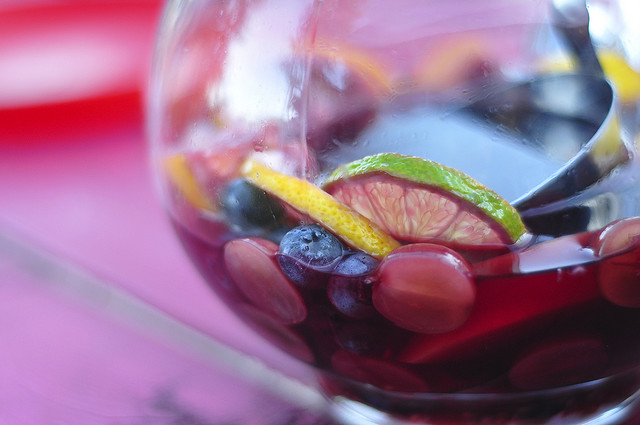
Remember your freshman year in college when you’d crash the fraternity parties and there’d always be one of those large plastic garbage cans full of red wine with chunks of fruit floating in it? That little sting of brandy lurking just behind the fruitiness of every cupful? Remember you and your buds trying to drink your way to the bottom of those garbage cans, party after party, weekend after weekend, with the same results every time: several of you getting violently ill and finding chunks of chewed fruit stuck to your socks the following day?
That was my introduction to sangria. It’s such a simple recipe: cheap red wine, cheap brandy and some fruit. Mix it all up, chill and you’ve got a delicious but cheap wine punch.
Of course that’s what red wine sangria was originally made for, getting drunk on the cheap.
The Origin Of Sangria
The drink hails from Spain dating as far back as 300 B.C., though the term “sangria”, which most accredit to the Spanish word for blood, “sangre”, wasn’t used until sometime in the eighteenth century. Probably because the dark red color of the mixture resembles blood and red wine had religious connotations associated with it in those times.
Fruit was added to cut the bitterness of young red wines and no one wine was chosen as the base for the mixture. It could be made from any red wine that was available. Also, the fruits that were added varied depending on the region and some sangria recipes even used spices along with fruit. At some point brandy was infused, in all probabilities, to fortify it for shipping and somewhere along the way soda water became a popular addition.
The flavor, like I said, is basically like a wine punch because it combines the subtle, sultry bitterness of wine with the sweetness of fruit. Although it has a long history in Spain and even throughout Europe, it was only first introduced on American soil in 1964 at the World’s Fair. Obviously, it has been popular ever since.
Ingredients For Sangria
Wine is always a key component. My personal thoughts on making sangria from home is to use a cheap red wine. Why? Because it’s going to be mixed with a lot of stuff. Why ruin a fine wine for something not intended for a classy event? So, go cheap. Most of the red wines used in Spain would have been on the dry side, so follow suit as best you can.
Although red is commonly used, there are recipes that call for white and some that use both. For our purposes, we’re sticking to red only. You also need a strong, straight liqueur like brandy, although flavored brandy is adequate.
Next, you need plenty of fruits or berries, whatever you prefer or whatever is in season. Including these in your recipe can be a challenge because they do not keep very long; the best means of combating this problem may be to keep some frozen fruits on hand or to just grab the amount you need at the time. When choosing fresh fruit, get the ripest you can find. Bordering on turning is the best.
The next element to include is optional: herbs. Orange peel can add some zest, ginger some spice, or cinnamon some sweetness.
Mix all those together, add ice, and you will be good to go.
Best Red Wine For Sangria
There is no right answer as to which red wine goes best in a sangria recipe. Fruit is added to contrast the bitterness and bitterness is usually associated with dry wine; so it is recommended that at least a dry red wine be used. The one that is best depends on your personal preference. That is part of the charm of this Spanish beverage, the fact that it is so versatile. Choose a wine that you like best, and stick to using that one in your recipe. Another helpful tip to make it more authentic is to go with a cheap Spanish red; tests have shown that the cheaper options are more flavorful in most recipes.
Red Sangria Vs. White
Since sangria takes its name from its blood-red color, it is traditionally red. In recent years, though, some have begun experimenting with using a white alternative. In Spain, red sangria was more popular because red grapes grew well in local vineyards; however, certain regions where sparkling wine was being produced branched out into using similar ingredients to create a white version. The only difference is preference.
Red Wine Sangria Recipe
This is a classic style of sangria, but remember, there is no traditional recipe.

1 bottle (750 ml) of chilled cheap red wine
1 orange, sliced
1 lime, sliced
½ lemon, sliced
1 ½ ounces of brandy
12 ounces club soda
2 tbsp sugar
ice
Start dropping your orange lime and lemon into a fairly large pitcher. Pour the brandy and sugar over the fruit. Stir (Optionally: Gently mash those ingredients for about one minute; the fruit should have released some juice without being crushed) until the sugar dissolves. Next, pour in the chilled red wine. Refrigerate the mixture for at least two hours and no more than eight hours. When ready to serve, add club soda and ice.
Sangria is a delicious, exotic, and versatile beverage that is used on all manner of occasions. You can buy premade sangria (and some it is really good) but why not have some fun by making it yourself and making a day of it with friends and neighbors at your next cookout?
Keep in mind that sangria is a drink for festive occasions. I won’t tell you how much of a tourist you will look like if you order sangria in a bar in Spain. They will have it, but you’ll only see other tourists drinking it.


Speak Your Mind